Access in the New World
Winning in the 20s: How access needs to evolve.
Access has become the front and center topic for the pharmaceutical industry. Majority of pharma companies now have explicit goals and commitments to patient access at the executive level and in their mission statements. Simultaneously, “Access” has become part of the agenda of multiple functions and the role of the Market Access function is rapidly evolving to become that of an orchestrator of Access across the organization.
“Access as corporate objective” is increasingly used in the industry, without necessarily a precise definition of what it actually means or entails for the Market Access function itself. This paper proposes one way to structure the discussion on what Access in the New World could look like. With that objective in mind we discuss the following themes in this paper:
Click to enlarge

- How is the world (internal and external to Pharma companies) changing? Lay out external and internal trends that are impacting Access as a function.
- How has this affected the Market Access function? Take stock of how Market Access functions and “Access” more broadly has evolved in the past years.
- What does this mean for Access in the 20’s? Articulate implications for the Market Access function, and capabilities required in the near to mid-term.
In this paper, we consistently use the term “Market Access” when we refer to the function, and the term “Access” when we more broadly describe the ambition to reach as many patients as fast as possible.
Trends impacting access
Changes in external environment & internal collaboration impact the Access ‘sandbox’
Co-authors (Click to enlarge)
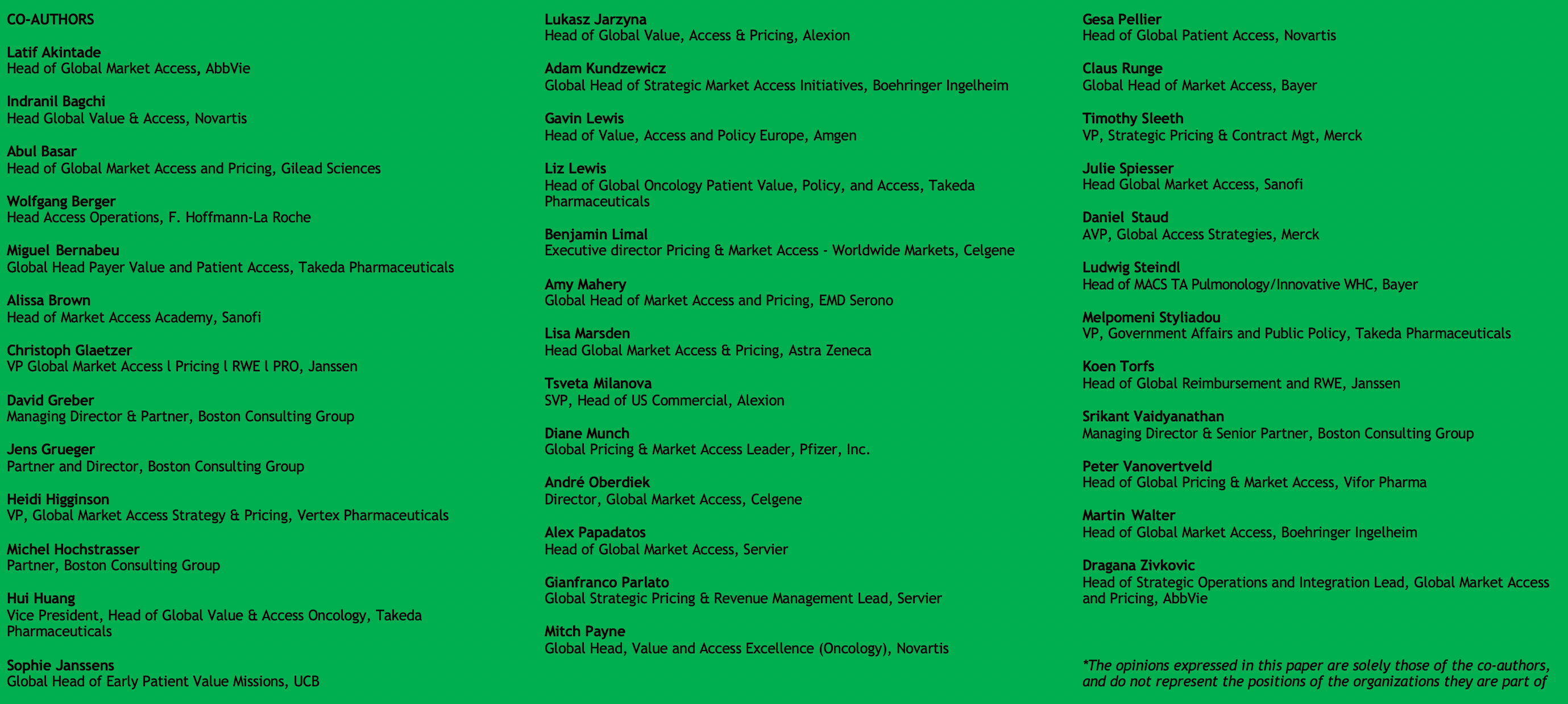
Many developments within and beyond health care impact patient Access, and the Market Access functions. Without claiming completeness, the BCG Market Access Roundtable believes Seven trends particularly influence Access going forward:
- Healthcare system sustainability remains a challenge, even if the spend on drugs has stayed constant as a percentage of GDP in most developed countries. This has been further highlighted by the COVID 19 pandemic.
- Universal health coverage is on the agenda of many emerging countries, increasing the pressure on industry to find ways to make essential medicines available to patients everywhere.
- Regulatory pathways are evolving, and regulators are willing to accelerate approval based on non-traditional evidence (e.g. single armed trials), while HTA and payers remain conservative expecting a higher burden of proof (RCTs Vs standard of care).
- New curative therapies and further stratification of treatment options based on next generation sequencing (NGS) and imaging (e.g. tumor agnostic therapies) provide transformational benefits to patients, and come with high uncertainty around comparative effectiveness and long-term outcomes requiring new approaches to assessment and payment.
- We are at the beginning of a digital revolution in healthcare. Sensor data, digital biomarkers and digital health apps are becoming ubiquitous, creating more complex offers that do not fit into traditional regulatory and HTA pathways.
- Real world data has become indispensable and the FDA label expansion of Ibrance for male breast cancer provides a pathway that will be utilized more in the future. Complementing that are improvements in analytical approaches that can help create external controls and causal analyses based on non-randomized data.
- A broader set of external stakeholders need to be understood and engaged with in new ways given their differing perspectives and needs. In addition, diversity in country and above country level response are expected to continue as evidenced during COVID 19.
Evolving market access functions
Along with the increasing importance of Access externally, the internal role Market Access functions and “Access” more broadly has seen a tremendous change
The internal role of Market Access functions has evolved and is expected to provide more strategic leadership for the organization across all functions that are touching on Access relevant topics:
- While still in flux, many companies now have integrated Market Access functions that cover Access strategy, pricing, value and evidence, and sometimes aspects of public affairs and policy those pertaining to Health Policy.
- The Head of Market Access is consistently in the local leadership team, and at global level mostly at Pharma CEO-2 (but on the speed dial of the CEO or the COO of the organization).
- Market Access has expanded from a technical function to one having a broader remit with dedicated Access Strategy Leaders representing the Access perspective in the development of integrated evidence and commercialization strategies alongside commercial, regulatory and medical in brand/product teams.
- In addition, other functions have built dedicated capabilities related to Access:
- Medical Affairs assumes a broader role in defining and executing RWE studies that impact HTA and coverage decisions
- Regulatory and Development design evidence generation plans that go beyond regulatory approval and enable speed to patient (vs marketing authorization)
- Public policy / corporate affairs are engaging stakeholders within and outside of Health Care on policy matters relevant for Access
- Marketing & Sales drive commercial arrangements with sub-national authorities (hospital trust, regional commissioning group) to allow faster & broader Access.
- While the Market Access function continues to provide expertise and guidance on aspects of value, evidence and policy, broader patient Access objectives are now formulated at the level of the executive committee and shared across functions.
In the past, it was primarily a technical excellence function that was outside of the core areas of clinical development, regulatory approval and commercialization. Today, Access is on the agenda of many functions and Market Access has created strong interfaces, typically as a core member of development and brand teams, providing expertise and being accountable for key parts of the development and commercialization strategies and plans.
Figure 1: The scope and role of Market Access over time
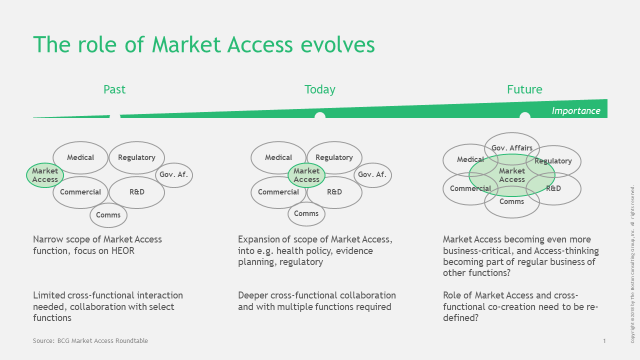
The trends that we discussed above will only accelerate this transformation: Access will become even more critical to the corporate and brand strategies, functions like clinical development and commercialization will have shared goals with the Market Access function and take accountability for selected deliverables and capabilities required for Access, This then poses the natural question – what role should Market Access be playing in the future?
The 2019 Market Access Benchmark conducted every three years by the BCG Market Access Roundtable revealed three key insights relating to the evolution of the Market Access function1:
1. Market Access functions went from a period of growth to a state of flux
- In 2016, Market Access functions in most of the pharmaceutical companies grew across Global, Region and Local level. In 2019, the picture is slightly more nuanced: some companies still grow their Market Access functions, but at a slower rate, while others maintain and begin to shift resources between Global, Region & Local.
- Most companies changed their Global Access leadership in the last 3 years and there is a dearth of Market Access leadership talent in the industry.
- Market Access functions are reconfigured, either reorganizing existing activities or bringing in additional activities – mostly Health Policy - under the Global Market Access umbrella.
2. Many companies are "experimenting" with alternative organizational models for Market Access (e.g., BU structures, agile project-based models), based on approaches the rest of the organization is taking
- As many pharmaceutical companies strengthen their franchise or business unit focus, Market Access functions follow suit and structure more resources along BU’s
- To improve cross-functional collaboration, many companies are piloting agile ways of working, i.e. smaller, empowered, cross-functional teams that drive strategy and commission sprints to test and develop new tactics and solutions based on minimum viable products
3. New skills relating to external and internal stakeholder engagement and co-creation seen as key capabilities going forward
- 300+ individuals were asked to identify the most important capabilities in Access going forward: across the top 10 capabilities identified, greater than half relate to collaborating and co-creating with internal and external stakeholders
- Given the fast-evolving external dynamics that are the number of functions required to define a robust Access strategy has increased thus necessitating new ways of collaborating / co-creating internally and externally
Implications for market access function
Implications and capabilities for Access in the 20s
These changes are expected to have profound implications for the Market Access function. We expect to see changes in scope, role and capabilities in the next ~3 years.
1. Adapted scope, role and capabilities in the next ~3 years
Market Access will still be focused on core Access topics such as value, pricing and evidence at a product and portfolio level, as well as policy shaping in areas like value frameworks, health system strengthening and affordability. The function will continue to drive internal capability building and experience sharing of the ongoing changes in the external environment. In addition, Market Access will help the entire enterprise understand the pricing and affordability dynamics globally and how this impacts Access in the short term and innovation in the mid to long term.
Furthermore, Access is increasingly impacted by developments broader than health care. For example, more patient and disease data is collected through innovative tools like sensors and wearables, and by different stakeholders. To leverage the real world data to help accelerate and sustain Access, companies will need to consider Access to and use of real world data in the context of data privacy regulation – a domain that has largely been dominated by consumer companies where the considerations are different. Thus, purview of “Access” naturally expands, and health policy aspects become increasingly important.
To achieve the Access objectives in this broader setting, Access leaders will also need to become more adept at translating complex Access themes into simple messages and become effective communicators internally and externally.
Based on the above the Roundtable identified three complementary roles Market Access will need to play in the future:
Figure 2: Three complementary roles Market Access will need to play in the future
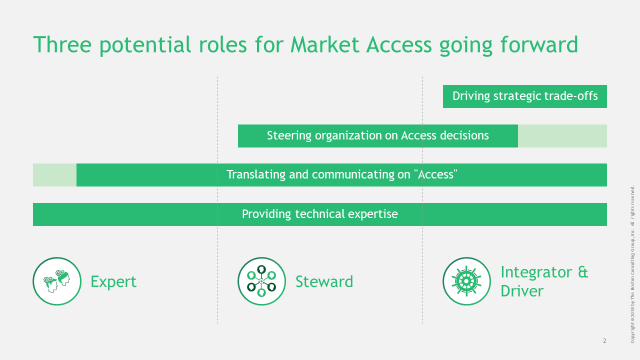
- Expert: Covering the ‘traditional’ roles of Market Access (e.g. value, pricing, HTA / Health Economics, Health Policy), and ‘new’ technical expertise, e.g. related to data generation / advanced analytics / data privacy, as outlined above. Experts will be responsible for developing and implementing functional plans and deliverables (e.g. Global Value Dossiers, HE models, Systematic Reviews, RWD study objectives).
- Steward: Setting the direction and guiding the organization around Access objectives, sensing the external environment and bringing in latest thinking to shape global and local strategies. Additionally, Market Access will collaborate with public policy in helping define the external policy agenda and stakeholders/ forums to engage with.
- Integrator & Driver: Coordinating inputs from different parts of the organization towards rapid and broad Access, ensuring that all needs are accounted for and helping drive trade-off decisions that affect Access. While each specific function is responsible for their respective activities – Market Access should be responsible for integrating the viewpoints and developing one holistic view.
Figure 3: Details on three complementary roles Market Access will need to play in the future
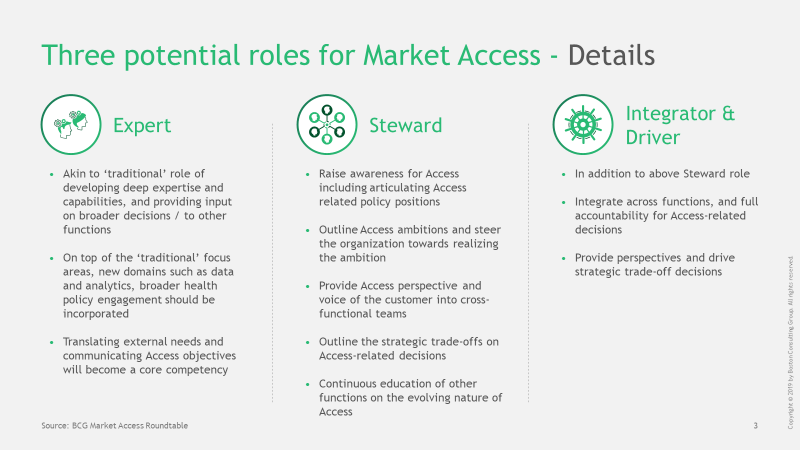
2. Broader potential organizational implications with a longer time horizon
In the context of the above the Roundtable explored potential future operating model options for the Market Access function. We explored addressing the challenges and opportunities across multiple dimensions:
- Building new capabilities (e.g. advanced analytics, health policy)
- Combining with other functions (e.g. Medical, Marketing) to realize synergies)
- Driving coordination between different functions
- Devolving Market Access capabilities to other functions
Combining the different dimensions, we explored six different operating options that are depicted in Figure 4 below.
Figure 4: Six operating model options
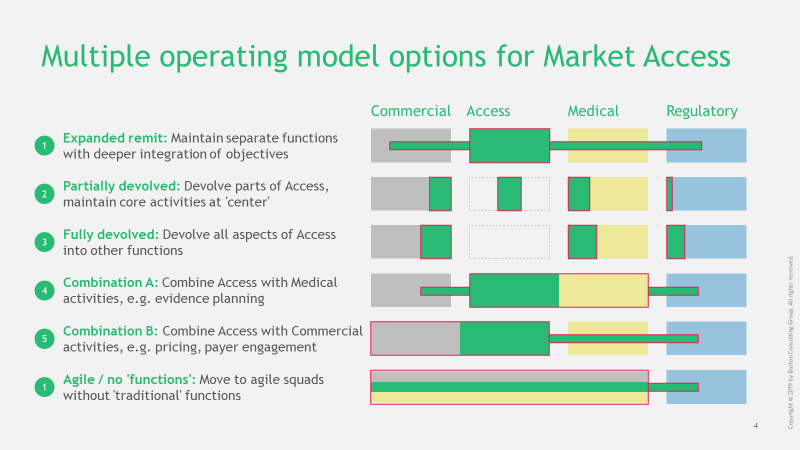
In the first option, the Market Access function will further expand its remit and build capabilities and resources that champion the Access, HTA and payer perspective across commercial, medical and regulatory functions.
Some companies may follow the option 2 in which the Market Access function will focus on core Access activities around value, evidence and pricing, while activities that are closer to commercial (e.g. key account management), medical (e.g. integrated evidence planning and real world data) and regulatory (engagement with regulatory and HTA stakeholders) will be covered by these respective functions under the overall leadership and coordination of the Market Access function.
This may even obviate the need for a dedicated Market Access function, if the Access objectives can be integrated into those functions (option 3).
Certain activities within Market Access and Medical could be combined, around integrated evidence planning, scientific advice and production of dossiers submissions for clinical scientific assessment (option 4).
Aspects around pricing and payer engagement could be integrated with traditional commercial functions (option 5).
And there could be an organizational design where traditional functions will be abandoned in favor of agile approaches that provide capabilities around commercial, Access and medical to drive a fully integrated development and commercialization strategy (option 6).
As always, no one size fits all. Companies will need to articulate the overall Access strategy, which will drive the required technical and leadership capabilities and guide the design of the Market Access function in the context of the overall organizational vision. Critical points to discuss include:
How will the chosen structure facilitate better collaboration and shared goals while maintaining clear accountabilities?
- What new capabilities are required?
- How do we attract & develop talent across capabilities/ experiences (technical & leadership) that are required for Access?
- How do we create an organization that has the flexibility to address accelerating changes in the external environment while maintaining technical excellence?
While we recognize all options are viable there was a general consensus within the Roundtable that option 1 where the Market Access function builds on its existing core expertise and takes on the role of coordinating and driving key trade-off decisions related to Access across functions – was the preferred option for most companies.
Conclusion and outlook
Winning in the 20s
The BCG Market Access Benchmark 2019 demonstrated a further maturation of Access as an objective, and Market Access as a function across all companies. While the focus in the past was around scope and size, it has now shifted to new capabilities and cross-functional leadership. In order to win in the 20s, Market Access functions will need to succeed across a number of roles: Experts delivering excellence for core Market Access plans and deliverables, Stewards for Access within and outside of the company, and as Integrators & Drivers of strategic trade-offs to deliver on company Access objectives. There will not be one organizational blueprint to achieve this and a lot will depend on the extent to which Market Access function can build their new and evolving capabilities, Leadership in driving Access related trade-offs. Companies will likely move towards joint ownership of key Access objectives, and along the way experiment with different organizational designs in the coming years. While we have discussed many options in this paper the one that seems most compatible with future needs seems to be one where we can combine – core functional excellence with strong ability to coordinate and drive trade-off decisions. Market Access functions globally would be well served to initiate soon internal discussions on the Role of the Access in the New World.